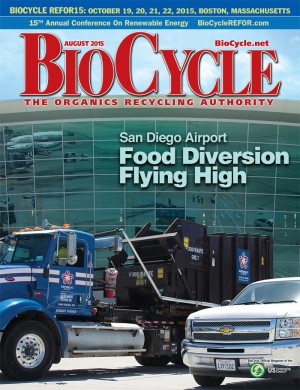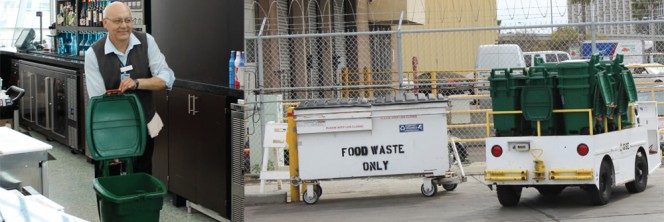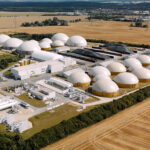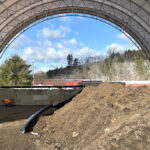San Diego International Airport diverts an average of 6 tons/week of food scraps, and serves as a model for other airports.
Ana Carvalho
BioCycle August 2015
 The San Diego County (California) Regional Airport Authority (SDCRAA) is expanding its social and environmental commitments to its community by developing a food donation and composting program to go along with its waste diversion initiatives at the San Diego International Airport. The new food donation program is providing the equivalent of approximately 5,000 meals/year for the San Diego region’s food insecure population, and it is just in its first stage.
The San Diego County (California) Regional Airport Authority (SDCRAA) is expanding its social and environmental commitments to its community by developing a food donation and composting program to go along with its waste diversion initiatives at the San Diego International Airport. The new food donation program is providing the equivalent of approximately 5,000 meals/year for the San Diego region’s food insecure population, and it is just in its first stage.
The airport is conveniently located near downtown San Diego and is host to 24 domestic air carriers and 5 international airlines, providing an average of 182,500 flights/year. While having the airport near downtown and somewhat centrally located in the region, its location may present some difficulties to its daily operations, as it assists the region’s efforts to reduce traffic and transportation-related greenhouse gas (GHG) emissions from the approximately 19 million travelers annually commuting to and from the airport.
Due to the amount of increased activity over the years, along with an aging infrastructure, the airport needed to expand and upgrade its terminal and operations facilities to account for the increase in traffic. As the airport prepared to complete its expansion and modernization, it followed the requirements needed to obtain the Leadership in Energy and Environmental Design (LEED) Platinum certification. The San Diego International Airport was awarded the LEED Platinum Certification in 2014 by the U.S. Green Building Council, and is currently the only airport in the world with this certification. The new terminal was designed and built reusing the existing old terminal structure. The terminal is also the world’s first airport to install LED lighting throughout the runway area.

Food scraps are collected in 13-gallon unlined bins (left) at each restaurant, and then transported to dumpsters marked “Food Waste Only” that are strategically located in the service areas behind several restaurant groups (right). Photos by Nate Clark
Before the completion of its expansion, the airport had only one food service provider, HMS Host, and source separated only coffee grounds and fruits for composting at the City of San Diego’s Miramar Greenery Composting Facility (Greenery). The airport’s average weekly loads to the Greenery amounted to approximately 1.8 tons. The organics were transported in one, 28-cubic yard roll-off bin. The airport also participated in a food donation program, giving unsold items to the local Food Bank.
Adding Food Scraps Streams
In December 2013, the airport finished its terminal expansion, which added three new foodservice providers — High Flying Foods, SSP America and Mission Yogurt. This resulted in a total of 40 new restaurants and coffee shops, and four main prep kitchens. In addition, the services of Paradies San Diego, a retailer that sells packaged food such as bags of peanuts, chips, chocolates, etc., were added. With the expansion completed and the arrival of additional foodservice areas, the airport was ready to implement a comprehensive food scraps separation program with the City of San Diego’s (City) Commercial Food Scraps Composting Program. All food scraps are allowed with expansion, not just the coffee grounds and fruits.
The City’s Environmental Specialist worked with SDCRAA’s Terminals and Tenants Department Manager and its custodian contractor, Flagship, to design a program that would optimize the restaurants’ limited kitchen space and staff time. The program also needed to be designed to function within the airport’s security requirements, and comply with the City’s food scraps composting program’s threshold of a maximum one percent contamination in the loads.
The collection program designed for the airport consists of food scraps collection in 13-gallon unlined carts at each restaurant and transportation to 2 cubic yard (cy) dumpsters. The wheeled carts allow for easy transport and have latching lids to eliminate vector problems. Ten dedicated Flagship staff members work on the program’s food collection and transportation logistics. They exchange full carts with clean empty carts at a minimum of three times a day from each restaurant. Restaurants can call for extra services if needed. When emptied, the carts are cleaned and returned to the restaurants.

Once full, the food scraps dumpsters are towed to a 20 cubic yard compactor located at the airport’s central disposal area, where they are emptied (left), cleaned and returned to their locations (compactor ready for transport, right).
The 2-cy dumpsters are clearly marked as “Food Waste Only” and strategically located in the service areas behind several restaurant groups. Once full, the dumpsters are towed to the 20 cubic yard food waste compactor located at the airport’s central disposal area, where they are emptied, cleaned and returned to their locations. The food waste compactor is then transported to the Greenery. The airport currently diverts an average of 6 tons/week of food scraps to composting.
With the large increase of new food sites and employees to operate them, the food collection program needed to be implemented in phases. This enabled proper training of all restaurant employees and facilities maintenance staff in addition to allowing time to observe the procedures established, refine any logistical problems, and catch any potential contamination problems before all locations were incorporated into the program.
The three phase expansion was divided as follows:
• Phase I completed in December 2013 included HMS Host’s 13 sites and main kitchen.
• Phase II completed in February 2014 included High Flying Foods’ eight restaurants, one main kitchen, and three storage areas.
• Phase III completed in December 2014 included SSP America’s and Mission Yogurt’s 19 sites and two main kitchens.
As part of the City’s commercial food scraps composting program requirements, the airport had to be in full compliance with the City’s Recycling Ordinance. City staff assisted the airport terminal manager with adjusting the existing recycling program to achieve full compliance with the requirements. As part of the recycling program, office staff were given larger, unlined recycling containers with an attached small lined trash container.
City and airport staff trained a total of 645 food and beverage employees and custodial staff on the enhanced recycling program and the new food scraps collection program.
The airport is also piloting a recycling collection program for its staff break rooms. Labeled “Mastering the Art of Recycling,” break rooms have specific locations for food scraps, recyclables and trash.
Donation And Source Reduction
The SDCRAA is working with its foodservice providers on implementation of a robust food donation program. Currently only HMS Host and Paradies have programs in place, donating over 3 tons/year of food, with an approximate fair market value of over $100,000, generating roughly 5,000 meals for food insecure San Diegans (calculated using Feeding America’s data of 1.2 lbs/meal in San Diego), with the additional benefit of the tax deduction.

Collected food scraps are transported to the City of San Diego’s Miramar Greenery Composting Facility where they are mixed with ground yard trimmings (left). Finished compost is screened using a Komptech system.
SDCRAA’s commitment to the environment is reflected throughout its terminals, educating and providing environmentally conscious opportunities for its users, such as minimizing water bottle usage through its many water refill stations, and replacing old drinking fountains with bottle fill stations. It also has liquid waste containment units at each security checkpoint to allow for the proper disposal of liquids and the recycling of their containers (mostly plastic bottles). The airport’s xeriscaping landscape conserves water and shows the beauty of drought tolerant plants to the City’s visitors. Concerned about all aspects of the comfort, safety and environmental footprint of its passengers and visitors, it offers six outdoor pet relief areas, and the very popular (and charming) indoor pet relief area, equipped with artificial grass and its own hydrant for the relief of its users.
The SDCRAA has been awarded with the City of San Diego’s “Recycler of the Year” award for 10 out of the last 15 years. In addition, it received the following awards in 2015 from Airport Revenue News in the Medium Size Airport category for its responsible and innovative environmental stewardship: Best Overall Concession Program; Airport with Best Amenities; Airport with the Best Customer Service; Airport with the Best Concessions Program Design; and Airport with the Best Concessions Management Team.
Ana Carvalho is an Environmental Specialist with the City of San Diego (CA) Environmental Services Department.













